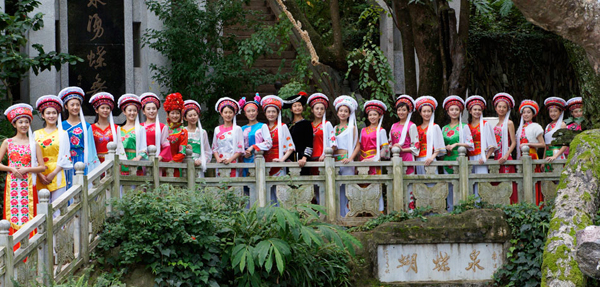The Bai people’s unique style of traditional dress was established during the Nanzhao Kingdom (738-902), which was a separate empire that ruled over Yunnan during the Tang Dynasty (618-907). The colour white signifies dignity and high social status to the Bai people and so they have a marked preference for white clothes, making laundry day nothing short of a nightmare! Generally speaking the men wear white shirts with white trousers, a white turban, and colourfully embroidered gaiters and belts, although nowadays most young men prefer to wear modern clothes and only don their traditional dress on special occasions.
The women have much more of a penchant for colour and, while the younger women predominantly wear white clothes, the older women mainly dress in blue and black. Young women will normally wear a white or powder-blue dress under a sleeveless pink, purple, red, blue or black jacket. Their clothes are embroidered with rich, colourful patterns, making laundry all the more difficult when it comes to separating the whites and darks! Under the dress they will wear a pair of loose fitting white trousers and embroidered shoes made of white cloth.
They embellish their outfits with a myriad of jewellery, including silver earrings, hairpins, necklaces, and jade bracelets. Elderly women wear far more muted attire and tend to opt for blue dresses and trousers covered by sleeveless black jackets and aprons. In Dali, many of the women wear a white coat trimmed with a black or purple collar that is complemented by loose fitting blue trousers and embroidered shoes. A bouncy ponytail secured at the tip by a red string usually indicates the woman is unmarried, while hair or braids clasped in a bun means you should take your amorous intentions elsewhere!
Most Bai women will wrap a sash around their waist, although the appearance of these waistcloths differs depending on age. Those worn by young girls are normally intricately embroidered and only reach down to their knees, while those worn by middle-aged women are purely blue or black in colour and are much longer. Their embroidery features many patterns and images, the most common of which is the camellia flower.
To the Bai people, the camellia is a symbol of beauty and their characteristic headscarves are designed to look like camellias in bloom. These headscarves are red with a white outer layer and are shaped like a crescent moon. The lower half or “tail” is embroidered with flowers and is meant to be draped over the shoulder so it sways in the wind. The unusual appearance of these headscarves has earned them the name “the flower in the wind and the moon on a snowy night”, although they could just as easily be called “the big hat on the head and the poor girl struggling underneath”!
